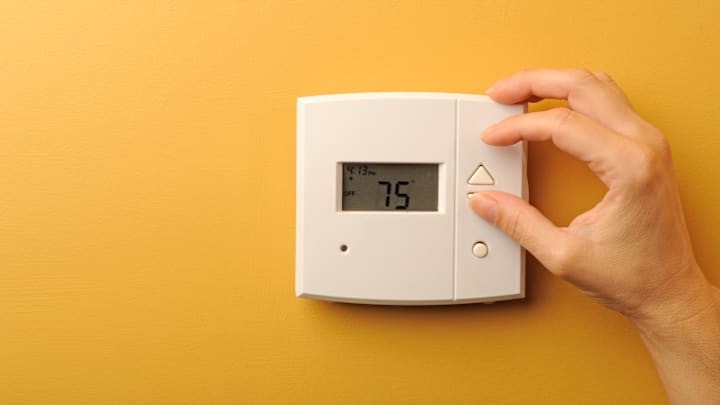The weather outside is frightful, so chances are your heating bill is beginning to soar out of control. With months between you and milder temperatures, you're going to want to keep your heating use in check. Here are some tricks for renters and homeowners to stay toasty without piling on the sweaters and blankets all winter long.
- Shrink Wrap Your Windows
- Seal the Attic
- Weatherstrip Your Window Frames
- Add Drapes
- Seal Your Foundation
- Stop Air Leaks Around Electrical Outlets
- Choose Energy-Star Appliances
- Do a Home Energy Audit or Assessment
- Turn Down the Thermostat
- Get a Smart Thermostat
Shrink Wrap Your Windows

Plastic wrap is an inexpensive insulation alternative you can use to block drafty windows, Thomas Baker, building technology editor at This Old House magazine, told Mental Floss in 2016. Baker suggested buying a kit (which you can find at retailers like Home Depot), to make the DIY job even easier.
Seal the Attic
“Sixty-eight percent of our heat loss [happens] through the ceiling in the attic, but we only lose 20 percent through the walls and 10 percent through our doors and windows,” said Anthony Stonis, president of Building Energy Experts, based in Crystal Lake, Illinois. “That’s why sealing the attic has a much faster return on your investments.”
Weatherstrip Your Window Frames
It’s typically not the window itself that’s inefficient, but the way it was installed, Stonis said. Luckily, fixing this is easy: Calk the area around the windows for the winter, he suggests.
Add Drapes

Adding curtains to your windows can reduce heat loss from a warm room by 10 percent, according to the U.S. Department of Energy. And if you opt for floor-length curtains you can pin together and attach to the walls with Velcro or magnets, you can bump your heat conservation up to 25 percent. The key is to open the drapes when the sun is shining so you’ll let the heat in at the peak times, then closing them when the sun goes down.
Seal Your Foundation
This most likely won’t be something you tackle on your own, but homeowners and renters can ask to air seal their foundation, attic, and plumbing and electric entrances to prevent unwanted leakage of conditioned air, either warmed or cooled. “In northern climates, properly installing insulation to levels called for by the local housing codes, when combined with air sealing, will also go a long way to reducing energy bills,” said David Lee, Residential Program Supervisor for the Building Technologies Officer at the Department of Energy. “In addition to saving money, this can also greatly improve occupant comfort.”
Stop Air Leaks Around Electrical Outlets
You could be letting hot air seep out through the outlets in your exterior walls, Baker said. Fix it by insulating your electrical outlets, which you can do by applying a foam gasket to the back of the electrical outlet plates and fill the receptacles with child-safe plug covers.
Choose Energy-Star Appliances

More than half of a home’s average energy consumption is due to heating, cooling, and water heating, says Lee. So Lee recommends focusing on those three areas in order to trim your bill. You could start by replacing your old appliances with more efficient ones that have the Energy Star stamp of approval.
Do a Home Energy Audit or Assessment
An audit can help homeowners understand their home’s energy use, which can help identify problem areas and fixes, Lee says. Check to see if a home performance audit with Energy Star is offered in your area. “An Energy Star contractor will perform a whole house audit and make recommendations to improve the overall energy efficiency of your home,” Lee added. “In many cases, these improvements can save from 20 to 30 percent on a home’s energy bill.”
Turn Down the Thermostat

“For every degree you lower the temperature for eight hours, you save 1 percent on your heating bills,” Baker said, so turn down the dial when you're away or sleeping. This doesn’t apply to radiant heating systems, however, because of the long time required to raise the temp after the room has gotten cold.
Get a Smart Thermostat
A smart home system, such as Nest or Honeywell, will recognize your daily patterns and automatically turn down the heat when you’re out of the house. The result: massive heating bill savings. Nest reports that the average person with a Nest thermostat saves 12 percent on their heating bill annually and 15 percent on cooling. This means the system will pay for itself in a couple of years.
Read More Winter Home Maintenance Tips:
A version of this story was originally published in 2016 and has been updated for 2025.
